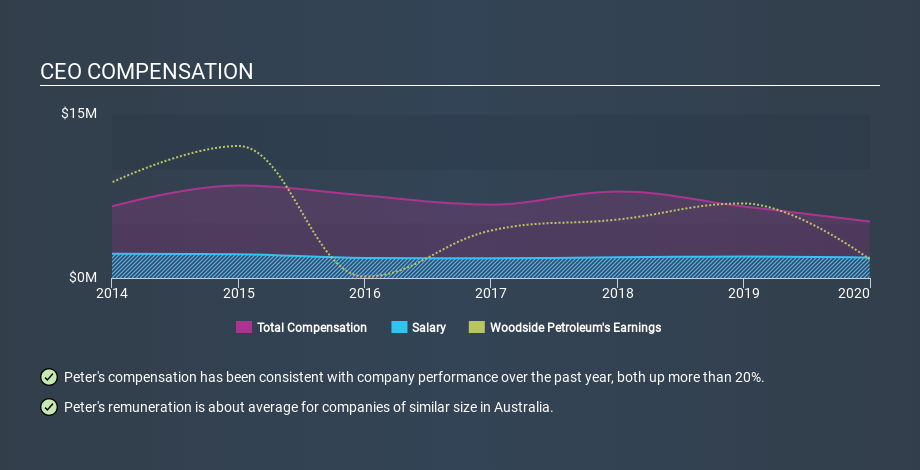Is Woodside Petroleum Ltd (ASX:WPL) Excessively Paying Its CEO?

Peter Coleman has been the CEO of Woodside Petroleum Ltd (ASX:WPL) since 2011. First, this article will compare CEO compensation with compensation at other large companies. Next, we'll consider growth that the business demonstrates. Third, we'll reflect on the total return to shareholders over three years, as a second measure of business performance. This process should give us an idea about how appropriately the CEO is paid.
See our latest analysis for Woodside Petroleum
How Does Peter Coleman's Compensation Compare With Similar Sized Companies?
According to our data, Woodside Petroleum Ltd has a market capitalization of AU$19b, and paid its CEO total annual compensation worth US$5.2m over the year to December 2019. That's actually a decrease on the year before. While we always look at total compensation first, we note that the salary component is less, at US$1.9m. Importantly, there may be performance hurdles relating to the non-salary component of the total compensation. We took a group of companies with market capitalizations over US$8.0b, and calculated the median CEO total compensation to be US$4.1m. There aren't very many mega-cap companies, so we had to take a wide range to get a meaningful comparison figure.
Next, let's break down remuneration compositions to understand how the industry and company compare with each other. Talking in terms of the sector, salary represented approximately 73% of total compensation out of all the companies we analysed, while other remuneration made up 27% of the pie. Non-salary compensation represents a greater slice of the remuneration pie for Woodside Petroleum, in sharp contrast to the overall sector.
That means Peter Coleman receives fairly typical remuneration for the CEO of a large company. Although this fact alone doesn't tell us a great deal, it becomes more relevant when considered against the business performance. You can see a visual representation of the CEO compensation at Woodside Petroleum, below.
Is Woodside Petroleum Ltd Growing?
On average over the last three years, Woodside Petroleum Ltd has shrunk earnings per share by 7.3% each year (measured with a line of best fit). It saw its revenue drop 7.0% over the last year.
Sadly for shareholders, earnings per share are actually down, over three years. And the fact that revenue is down year on year arguably paints an ugly picture. It's hard to argue the company is firing on all cylinders, so shareholders might be averse to high CEO remuneration. You might want to check this free visual report on analyst forecasts for future earnings.
Has Woodside Petroleum Ltd Been A Good Investment?
With a three year total loss of 30%, Woodside Petroleum Ltd would certainly have some dissatisfied shareholders. It therefore might be upsetting for shareholders if the CEO were paid generously.
In Summary...
Peter Coleman is paid around the same as most CEOs of large companies.
After looking at EPS and total shareholder returns, it's certainly hard to argue the company has performed well, since both metrics are down. Most would consider it prudent for the company to hold off any CEO pay rise until performance improves. Shifting gears from CEO pay for a second, we've picked out 4 warning signs for Woodside Petroleum that investors should be aware of in a dynamic business environment.
Arguably, business quality is much more important than CEO compensation levels. So check out this free list of interesting companies, that have HIGH return on equity and low debt.
If you spot an error that warrants correction, please contact the editor at editorial-team@simplywallst.com. This article by Simply Wall St is general in nature. It does not constitute a recommendation to buy or sell any stock, and does not take account of your objectives, or your financial situation. Simply Wall St has no position in the stocks mentioned.
We aim to bring you long-term focused research analysis driven by fundamental data. Note that our analysis may not factor in the latest price-sensitive company announcements or qualitative material. Thank you for reading.


